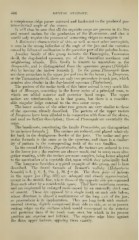Page 486 - My FlipBook
P. 486
496 DENTAL ANATOiMY.
a conspicuous ridge passes outward and backward to the produced pos-
tero-external angle of the crown.
It will thus be seen that all the requisite cusps are present in the first
and second molars for the production of the W-structure, and that it
would only require the presence of connecting ridges to complete it.
A distinctive characteristic of this, as well as most other marsupials,
is seen in the strong inflection of the angle of the jaw and the vacuities
caused by failure of ossification in the posterior part of the palatine bones.
Another family of this group includes the Phascogales, Tasmanian
devil, the dog-headed opossum, etc. of the Australian continent and
neigh boriug islands. This family is known to naturalists as the
Dasi/w'idce, and is distinguished from the opossums proper {^Didelphi-
d(e) by having the incisor formula |. In the genus Phascogale there
are three premolars in the upper jaw and two in the lower ; in jDastjurus,
or the Tasmanian devil, there are only two premolars in each jaw, which
number also obtains in the dog-headed opossum (Thylacuius).
The pattern of the molar teeth of this latter animal is very much like
that of Mesoni/x, consisting in the lower series of a principal cone, to
which are added anterior and posterior basal cusps. The npper
molars are tritubercular, as in that genus, but there is a consider-
able cingular ledge external to the t^\•o outer cusps.
The lower molars of the other two genera are very similar to those
of the opossum, already described. The pattern of the upper molars
of Dasyurus have been alluded to in connection with those of the shrew,
and need no further description ; those of Phascogale are essentially the
same.
The bandicoots, constituting the family Peramelidce, are distinguished
by an incisor formula |-. The canines are reduced, and placed relatively
far back in the dentigerous border of the jaws. The molar and pre-
molar formula is the same as in the opossum, and there is a similar-
ity of pattern in the corresponding teeth of the two families.
In the second division, Dipvotodoniki, the incisors are reduced to two
in the lower jaw ; the canines are always small, and in many cases alto-
gether wanting, while the molars are more complex, being better adaj)ted
to the mastication of a vegetable diet, upon which they principally feed.
The kangaroo furnishes a typical example of this group, and is here
described. The dental formula of Bennett's wallabv (Halmafurus
hmmiti) is I. , C. fi-, Pm. \, U. = 28. The three pairs of incisors
f f
in the upper jaw (Fig. 269) are subequal and closely a])proximated,
except in the middle line, where those of the opposite side are separated
from each other by a consideral)le sjiace. They have incisiform crowns,
and are implanted by enlarged roots caused by an unusually thick coat
of cement. These are opposed by a single tooth on each side below,
whose direction is almost a continuation of the long axis of the jaw,
so procumbent is its implantation. They are long teeth with enamel-
covered crowns, slightly compressed from side to side, so as to present
cutting edges on the sui-faces which would correspond to the anterior
and posterior faces if the tooth were erect, but which in its present
position are superior and inferior. The superior edge bites against
the three upper incisors, opposing them exactly.


